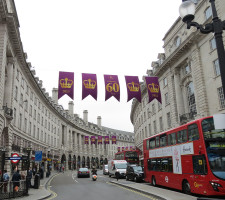
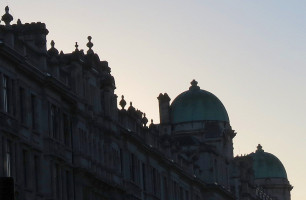
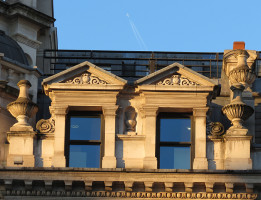
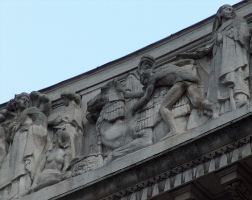
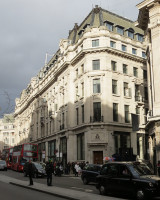
Regent Street, one of London s premiere shopping streets, is not an obvious place to look for sculpture, yet there are in fact two significant groups of architectural sculpture and a fair amount of minor decorative work, all dating from the early 20th Century.
Regent Street was part of John Nash s great scheme for a Parisian-like triumphal way from Regent s Park to the north, all the way down to St James s Park in the south, at the northern side of which stood the grand residence of Carlton House, at that time home of the Prince Regent. Nash s great works were commenced in about 1810, and Regent Street itself was complete in about 1825. Carlton House itself, the southern terminus of the scheme, was pulled down just about when Regent Street was completed, and Nash s Regent Street buildings were systematically demolished and replaced from about 1900 onwards: none survive.What we see today mainly dates from the 1900s through to the 1920s the rebuilding scheme was slowed by the First World War and today, the Crown Estate, the freeholder of the area, is replacing many of these buildings, leaving only the facades.
Pevsner, the great architectural historian and chronicler of the buildings of England, was rather dismissive of these buildings or facades, but with a 21st Century eye, we can perhaps look on them rather more kindly, and, if we have the patience, seek out the sculptural interest. Regent Street is in fact in three portions: a short portion north of Oxford Circus; the long main portion with all the grand stores from Oxford Circus south and east to Piccadilly Circus; and a shorter but grandly wide third stage down to Waterloo Place. This page considers only the long central portion, which has a high degree of uniformity of style, each block between the various side streets typically being a great Portland Stone block or fa ade, rather solid, lightly decorated, and with raised centres or corners to each block, but nothing too tall or greatly shorter than its neighbours. This is because although the architects of each block made their own designs, in 1898 a set of guidelines had been drawn up, by a certain Arthur Cates, which laid down the use of Portland Stone throughout, and that each block should be designed as a single piece; the Crown Surveyor, John Murray also had to approve each design. A somewhat French Classical post-Edwardian style thus pervades the whole street.
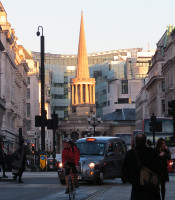 All Saints Langham Place from Upper Regent Street.
All Saints Langham Place from Upper Regent Street.
Oxford Circus is noted on the Oxford Street West page; here we note only that the architect was John Tanner, and the curvaceous buildings were put up in separate stages from just before WW1 to 1928. While we will not here note the buildings north of the Circus on Upper Regent Street, the best thing by far is the unforgettable view towards the beautiful round church at the top of it, which is All Souls Langham Place, a surviving work by John Nash himself. It catches the Winter sun beautifully on the spire. The town-planning point of the building, as Pevsner and many others have pointed out, is that it provides the perfect foil to the change in direction of the street, which as Portland Place goes off at an angle to the left (West) as we look at it. In front of the church is a modern portrait bust of John Nash.
Top end Regent Street by Oxford Circus, buildings by Henry Tanner, and sculptural details.
The top end of the main part of Regent Street going south from Oxford Circus is also by Henry Tanner; on the right hand side stands a great block through to Little Argyle Street with minor classical details: Ionic fluted pilasters, the odd keystone head, open pediments above some of the windows filled with cartouches; on the left hand side is No 251-59 Regent Street, an island site with similar sculpture to Oxford Circus itself: wreaths with winged cherub heads (if you like cherubs, see this page), cartouches, and carved lion s heads in a 20th Century idiom.
229-249 Regent Street, G. D. Martin, 1898.
Just beyond these groupings, on the West or right hand side as we proceed South, is the grand pile of nos. 229-249 Regent Street. The side wings are fairly plain, but the centre, which now houses the Apple Store, is a grand structure with a segmented dome which is particularly noticeable looking from the south side, or down Little Argyle Street which it faces across Regent Street. The building, dated at the top 1898, and thus one of the oldest survivors on the central part of the street (!), is by the architect G. D. Martin. Because the building was designed before the 1898 guidelines for the rebuilding of Regent Street were drawn up, it has a different look from the rest of the street and a strikingly different design. The central part of the building, nine bays wide further up, has four double-height and double-width arched windows at ground level and a central door, creating open fields formed by the spandrels (triangular spaces above the arches). Here are four single and two double-spandrel mosaics, and an almost continuous narrow band of mosaic above this stretching right across. These mosaics are most excellent, and really rather unusual example in England of Victorian mosaicwork decorating a commercial building exterior. Each of the single spandrels has a heraldic shield as the centrepiece, framed by two cornucopias, and with a ribbon bearing the name to which the heraldic design belongs. The double spandrels contain great roundels depicting heraldic beasts, and again each has a ribbon, with a red symbol below. Both single and double spandrels are each on a gold background,with a thick ornamental border around the edge in a repeating Arts and Crafts leafy design, as if by William Morris or William de Morgan. From the left we have:
Then after the central doorway:
Salviati Mosaics, London and Venice, former Salviati showroom (now Apple store).
On the ribbon above the principal mosaics, in red and gold mosaic as if made of damask, are blank labels on the left side, and on the right, the names of great cities: Paris, New York and St Petersburg.
All of this is the work of the great mosaicist, Salviati of Venice, and this was his London showroom. See this page for an introduction to London mosaic work of Victorian and Edwardian times.
There is minor sculptural decoration on the building too, including a range of ornamented spandrels to the smaller windows higher up, with turned pillar and drape designs, and little pediments to a few of the windows near the top which bear scrolling and the date of the building, 1898. Better are the various little pots near the top, in niches and free standing and at more than one elevation, very picturesque. Then the octagonal dome rises, copper probably, behind a balustrade, with little eyehole windows, and a cupola on top surrounded by further pots; at the very top is a weathervane. A splendid toehold of late Victoriana on mostly early 20th Century Regent Street.
Former Dickins and Jones builiding, Henry Tanner, with Egyptianising details.
On the opposite, Eastern side, after Little Argyle Street and through to Great Marlborough Street is the massive frontage of the former Dickins and Jones building, nos. 224-244, all rectangular windows and fluted square attached columns and pilasters with Egyptian architectural detailing, the best of which is the capitals of the pilasters, the horizontal carvings in the pediment positions above the windows, two heavy iron pots, freestanding, and the series of Egyptian lion heads with rings in their jaws above first floor level (for lots of carved lion head examples, see this page). A most convincing piece of architecture, by the architect Henry Tanner again.
Liberty's, detail, and the four statues of Oriental gentlemen.
The next block on the right is yet grander, the Liberty s Building, nos. 208-222 Regent Street, by the architects E.T. and E. S. Hall and completed in about 1926. The grand frontage is symmetrical, with two end blocks connected by an inwardly-curved central portion with a line of attached Ionic pillars, which rise three storeys up from their bases at 2nd storey level. In front of those bases are small Egyptian obelisks, each with a bronze collar bearing a symmetrical sculpture of a ship, so that the identical prow and stern are side-on to the viewer (if you like ship sculpture, see this page); at each of the corner positions on the building are a whole group of these, and between the obelisks is a balustrade. Beneath, above the first floor, which is not marked by any masonry, is a railing which has upon it four statues in bronze of Oriental gentlemen, seated cross-legged, and perhaps indicating the traders of the exotic Far Eastern goods to be purchased in the store. These are the most familiar statues on the building, for they confront the passer by on a double decker bus.
Upper sculptural frieze, and details, by C. L. J. Doman (Britannia), and T. J. Clapperton (examples of East and West).
But the main sculpture on the Liberty s Building is a long frieze of sculpture, the full breadth of the curved screen to the building, up at the top, which unfortunately is seen at too oblique an angle to be properly appreciated by the shoppers below, or, likely, even noticed by most. The frieze is the work of two sculptors: the central group by Charles L. J. Doman, and the outer ranges by T. J. Clapperton. The name of the whole ensemble is Britannia with the wealth of East and West . The central figure of Britannia, with Union Jack shield, trident, and helm, is conventional (more allegorical figures of Britannia on this page). She is flanked by a young boy, and a girl holding a lion, nicely Deco style, on the left as we look at the group, and on the right by an attendant, semi-nude, with a fan, and a seated, draped figure. Further out, we have on the left, or northern side, the wealth (trade) of the West, starting with the prow of a beached ship, complete with busty figurehead, sailors, and a variety of traders holding baskets etc, and a two-horse chariot also filled with produce. The East, on the southern side of frieze, shows the unloading of a sailing ship by various turbaned and generally more exotic Eastern figures; the chariot we saw on the left is here balanced by a seated camel (for more camel sculpture, see this page). The examples above show one figure leaning over the top, a not unusual affectation adopted by sculptors from Edwardian times onwards.
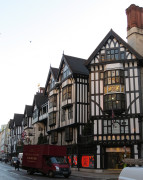
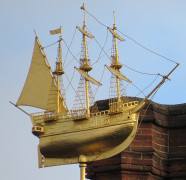 Side view of Liberty's, and the ship weathervane.
Side view of Liberty's, and the ship weathervane.
Retracing our steps a little, we should mention that down Great Marlborough Street we can see the other frontage of Liberty s, which is by the same architects but in entirely different, Tudor style, with much interesting carving, and, catching the eye from Regent Street, a weathervane in the form of a tall ship.
223-227 Regent Street, cartouche, and view of St George Hanover Square down Maddox Street.
On the opposite side of Regent Street, between Hanover Street and Maddox Street is nos. 223-227 Regent Street, nine bays wide plus angled corners on an island side, with the front to Regent Street rather narrow, and spreading out behind. We note carvings of cartouches, flowery brackets, and attached flaming urns higher up. Down Maddox Street we can see the elegant spire of St George Hanover Square, the creation of the architect John James and completed in 1725, one of the '50 new churches' (a dozen were built), and predating John Nash s creation of Regent Street by a century.
203-221 Regent Street, roof ornament, carved keystone head, winged staff with wreath, and lion head.
Next on this western side past Maddox Street, the long building facing Liberty s, nos. 203-221 Regent Street, is a rather flat-fronted block of a building with receding upper storeys. The minor sculptural decoration, rather lost in the scale of the building, includes a keystone head to a protruding central window, lion heads on brackets below, a winged staff with wreath in bronze, too small, and at the corners of the building on top, acroteria ( ears ) in the form of glossy cartouches. There are also several of the 1920s lion heads above the first floor; the one above is round the corner of the building in Conduit Street. Note that the first pictures are taken looking in the opposite direction to that which we are travelling - I took them in this direction because the light was so beautiful.
W. Woodward's 184-186 Regent Street, 1899, and 173-201 Regent Street with giant Ionic pillars.
The next portion of the street after Conduit Street on the west, and the little alley called Foubert s Place on the east, are long, flat-fronted blocks impressive by their scale rather than their adornment. Hamleys is on the left, and next to it, nos. 184-186 Regent Street is another Victorian survivor, dated 1899 and by the architect W. Woodward, somewhat more flamboyant and Italianate than the neighbouring ranges, with many flowery arches over the windows, and balconies with a variety of stone and iron railings. The outer ranges, of early 20th Century date, have various small adornments, including winged cherubic heads with garlands and several ornate cartouches, to add to our collection of cartouches along Regent Street, and along the top balustrade a series of free-standing pots which make a good skyline when seen from further along the street - see 4th picture above. On the other side, nos. 161-201 includes a central portion with six giant, fluted Ionic pillars, and minor ornament of shells and leaves. F. T. Verity (1869-1967), son of Thomas Verity, designer of many Victorian theatres, was the architect.
156-170 Regent Street, the Robinson and Cleaver linens building, turn of the Century with later infilling.
Next along on the East, left hand side, is nos. 156-170 Regent Street, with distinctive red granite and dark brown corners, looking late Victorian or likely Edwardian, with towers above with green domes at the corners of similar date, and a balustraded centre looking rather unornamented for that date, but fitting well in terms of elevations with the rest of Regent Street. The building is in fact like some old church, where the upper portions have been modernised and replaced, but the heavy corners and lower walls survive: an old photo from the early 1900s shows how the centre of the building has changed. The variation of scale is much more in keeping with what Regent Street had been like in Nash s time, and the lion statues at the top stand against the skyline (for more lion statues see this page). There is an intriguing raised centre with a statue of Mercury in the old photo, and what appear to be two eagles. Although that group has gone, the lions happily survive, as do the entirety of the end blocks the one further up Regent Street is not shown in the old picture, but is similar to that shown, and includes two cartouche panels with low relief sculpture of wispily attired girls. Other, rather whimsical sculptural details are on the towers, needing binoculars to appreciate: keystone heads with strange expressions, and masks of satyrs with small festoons hanging from their horns (for Keystone heads see this page, and satyr sculpture examples, see this page). These towers and the somewhat altered ground floor are what survives of Robinson and Cleaver, renowned linen manufacturers of Belfast, Northern Ireland. Their sign, an entwined R & C, can still be seen on cartouches and within wreaths on the frontage. (Incidentally, in Belfast itself is a fine statue emblematic of Linen manufacture, and textile manufacture more generally: see this page.)
Details of buildings left and right after New Burlington Street and Beak Street.
On the right hand side, past New Burlington Street we arrive at nos. 133-151 Regent Street, stretching to Heddon Street, and of which part at least is called Heddon House. A very long building, rather flat fronted, with square pots above the fourth floor, the central range above No. 151 etc with attached Ionic pillars, a few flowers and lions heads and cartouches, and two passageways underneath, one of which is the curling end of Heddon St, the other New Burlington Mews. Henry Tanner was the architect.
Opposite this latter part of the building, back on the right hand Eastern side, the building after Robinson and Cleaver, across Beak Street and through to Mappin and Webb at no. 132, thus nos. 132-150 Regent Street, is another rather undecorated building, by Henry Tnner again, notable mostly for its tall pairs of Corinthian pillars which have above them carved Greek triumphs, that is to say shields (blank ovals here) with crossed weapons behind them, and each with a Greek helmet on top. For more examples of pillar sculpture, see this page.
Westmoreland House, Art Deco sculpture for R. W. Forsyth building, architect John Burnet.
Mappin and Webb borders onto Regent Place, a pedestrianised lane, on the left; on the Western, right hand side opposite this is Heddon Street, as mentioned above. It is on the latter side that we have our other major building with statues, nos. 117-131 Regent Street, Westmorland House, and Vigo House, which runs through to Vigo Street: about 14 bays long facing to Oxford Street, or more if you count the curves at the corners, and a short green-domed tower on each corner, as we have seen earlier. But these towers each have in front of them two stone figures of standing females. They are classically draped, elegant in an Art Deco manner, with short hair, and long, elegant fingers to their expressive hands; each holds up some accoutrement: a small ship, or the surviving hull of it for one, and for her sister, a small statue of a nude girl, seated gazing over her shoulder. Part way up the corner tower of the southern end is a further statue of a girl, seated cross-legged, and holding a spinneret and threads: she is The Spinner, by the sculptor William Reid Dick, put up for the Scottish clothing company of R. W. Forsyth the building is the work of a Scottish architect, John Burnet, and he was the architect of the Glasgow headquarters of that company too, in Renfield Street the Regent Street building was completed in 1925. We may note a variety of little repeating feminine figures on the ironwork on this building, and a larger cherubic thing with a shield.
106-130 Regent Street, by Henry Tanner.
The other side opposite this long range is nos. 106-130 Regent Street, starting with Russell and Bromley, Henry Tanner again, with sculptures of cherubic heads above wreaths, recalling his Oxford Circus building, a small central pediment with a head of Hermes, not a prominent feature, a bit of other minor sculptural decoration, and French mansard roofs at the ends.
The Quadrant, lines by Nash, left hand pictures of Blomfield's buildings; right hand, of Norman Shaw's Piccadilly Hotel.
Before proceeding further, we should note the splendid view in front, of the curve of the Quadrant, following Nash s original lines, round to the left. The curve really commences where Regent Street is crossed by Vigo Street to the West, Glasshouse Street to the East. Both left and right hand side have further mansard roofs, with nice gilt acorns on top, and the block on the left, no. 104 Regent Street and lower numbers, looks particularly good because of the narrowness of the wedge shaped corner. All this is the work of the architect Henry Blomfield, with pairs of gargantuan pillars in front of recesses, passages underneath to Swallow Street and an arcade, very little sculptural decoration, and three last buildings to note. The most important is on the right hand side, which is the rear of the Piccadilly Hotel, paired Ionic pillars above arches, the work not of Blomfield but of Norman Shaw. Dating from 1905-8, it was this building whose elevations and style set the tone for the whole rebuilding of Regent Street. Between the pillars are round windows encircled by wreaths of carefully carved flowers and fruits; with further festoons above and hanging bunches to each side. These were the work of the firm of F. J. Barnes of the Isle of Portland.
On the opposite side we must mention en passant the former Caf Royale, the last work we shall see by Henry Tanner (1923-26, with surviving Victorian interiors).
And finally, the ends of the Quadrant to Piccadilly Circus have a most distinctive building on each side: to the south side, the former Swan and Edgar building, by Reginald Blomfield, put up in 1925-27, with pots at the top, and to the north, the County Fire and Alliance Life Office, with its statue of Britannia seated on a lion looking out over the Circus. This building is also by Blomfield, with some recognition in its design for the previous County Fire Office on the site; the arches on the ground floor look identical to the old building, and mark the point beyond which Nash's colonnade had begun. The former building also had its statue of Britannia seated on a lion, which old pictures show to have been rather similar in appearance to the one shown here, but with the lion's head not in profile, but turning towards the front, or street side.
Swan and Edgar Building, and statue and building for the County Fire and Alliance Life Office.
North and West along Oxford Street // or the other way going East // or North to Portland Place
Continue South East into Piccadilly Circus // or turn West along Piccadilly
London sculpture // Architecture pages
Visits to this page from 25 Jan 2014: 25,573